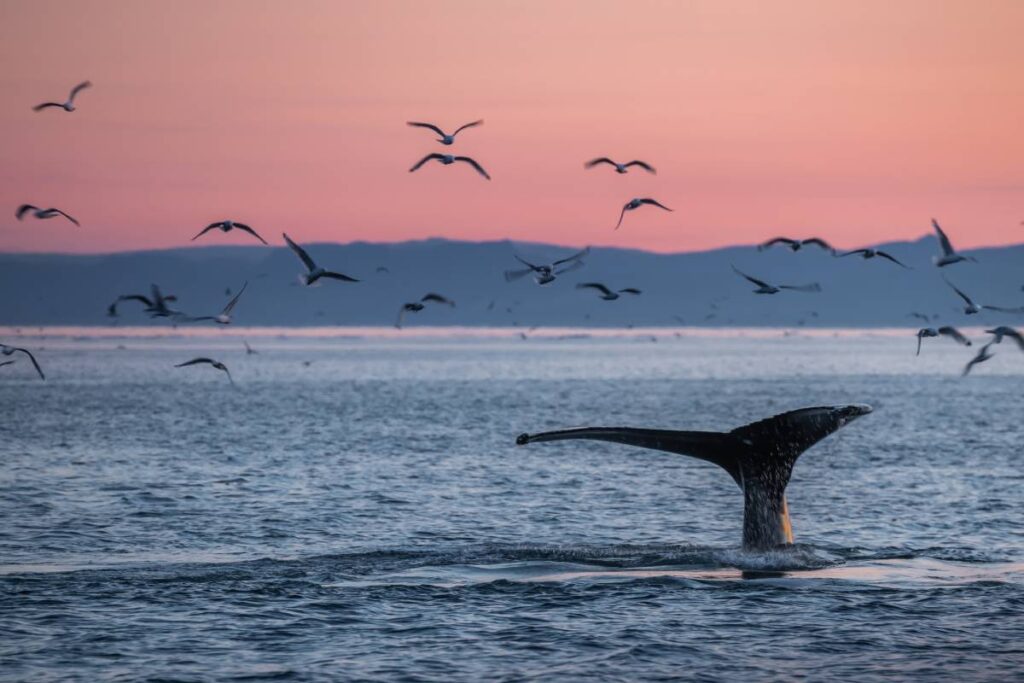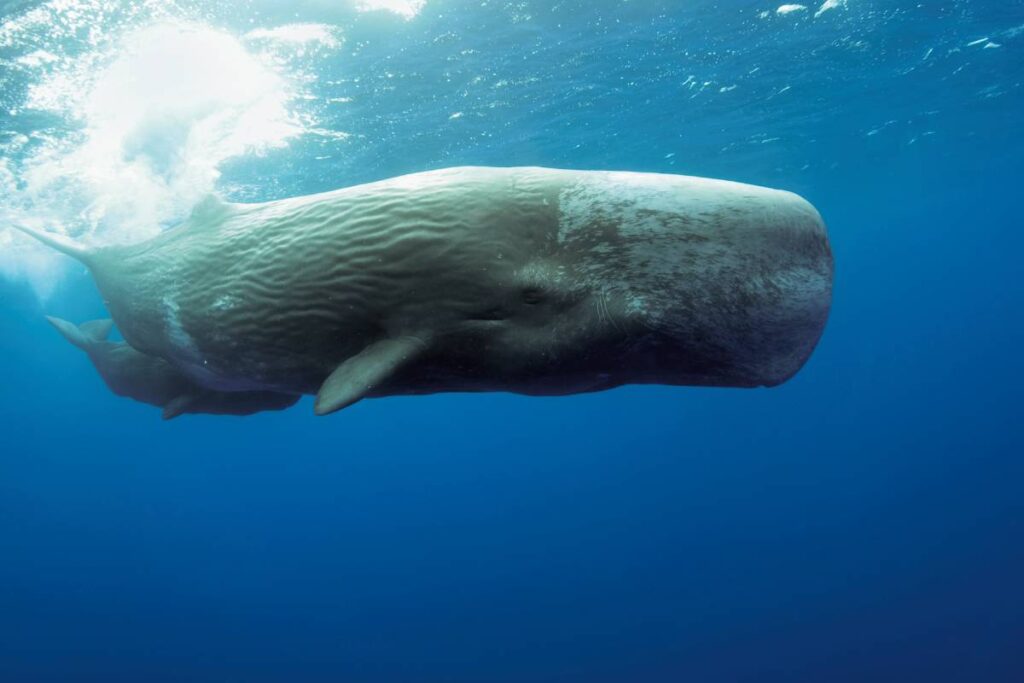When you see a whale gliding gracefully through the ocean, its massive body and fish-like appearance might make you think it’s just a giant fish. But in reality, whales are far more fascinating than that. These incredible creatures are mammals, not fish, air-breathing, warm-blooded animals that nurse their young and share surprising similarities with humans.
Whales have captured human curiosity for centuries, not only because of their enormous size but also for their intelligence, mysterious songs, and vital role in the ocean ecosystem. From the majestic blue whale, the largest animal ever known, to the playful humpback and clever orca, each species tells a story of survival and adaptation in the vast seas.
In this article, we’ll answer some of the most common questions about these marine giants: Is a whale a fish or an animal? What are five amazing facts about whales? And are whales almost extinct? Dive in as we explore the science, beauty, and urgent conservation needs of one of nature’s most extraordinary creatures.
Is a Whale a Fish or an Animal?

Let’s clear up the confusion once and for all: A whale is an animal, specifically a marine mammal. While fish and whales share similar habitats, their biological and anatomical differences are striking.
1. Whales Breathe Air
Unlike fish that use gills to extract oxygen from water, whales breathe air through blowholes on the top of their heads. These blowholes connect directly to their lungs, allowing whales to come up to the surface to inhale and exhale. You’ll often see a spout or spray of mist when a whale surfaces; that is the whale exhaling air and moisture.
2. Whales Are Warm-Blooded
Fish are cold-blooded, meaning their body temperature changes with their environment. Whales, on the other hand, are warm-blooded mammals. This allows them to maintain a stable body temperature even in the icy waters of the Arctic or Antarctic.
3. Whales Give Birth to Live Young
While most fish lay eggs, whales give birth to live young. Whale calves are born underwater and immediately swim to the surface to take their first breath of air. The mother then nurses her calf with milk, a characteristic unique to mammals.
4. Whales Have Hair (in Small Amounts)
Although you may not notice it, whales do have small amounts of hair, especially around their mouths and heads. These tiny hairs serve as sensory tools, helping them navigate their environment, another mammalian trait.
5. Whales Nurse Their Young
Female whales produce milk and feed their babies through mammary glands. Calves consume large quantities of rich, fatty milk to grow rapidly and survive in cold environments.
In summary, whales are air-breathing, warm-blooded, live-bearing mammals that nurse their young, all key characteristics of mammals. So while they look like fish, their biology firmly places them in the animal kingdom’s mammal class.
What Are 5 Fascinating Facts About Whales?

Whales are among the most remarkable creatures on Earth, not only for their immense size but also for their intelligence and ecological importance. Here are five incredible facts that make whales truly special:
1. The Blue Whale Is the Largest Animal Ever Known
The blue whale (Balaenoptera musculus) is the largest animal to have ever lived on Earth, even larger than any dinosaur.
- Length: Up to 30 meters (98 feet)
- Weight: Up to 200 tons
A single blue whale’s tongue alone can weigh as much as an elephant, and its heart can be the size of a small car. Despite its massive size, the blue whale feeds primarily on tiny shrimp-like creatures called krill. During feeding season, it can consume up to 4 tons of krill per day.
2. Whales Communicate Through Songs and Sounds
Whales are known for their complex communication systems, particularly the humpback whale, which produces long, melodic songs that can travel for miles underwater.
Scientists believe these vocalisations are used for various purposes, including:
- Attracting mates
- Navigating through the ocean
- Coordinating within pods
- Signalling danger or territory
Some whale songs can last up to 20 minutes and be repeated for hours. Interestingly, many whale species become more active and vocal at night, when the ocean is quieter, similar to nocturnal animals that thrive after dark. This behaviour shows just how adaptable and sensitive whales are to their environments.
3. Whales Play a Vital Role in the Marine Ecosystem
Whales are not just magnificent animals; they are key players in maintaining ocean health. Through their feeding and movement, whales help distribute nutrients in the ocean.
When whales dive deep and return to the surface, they release waste products that are rich in nutrients like iron and nitrogen, which stimulate the growth of phytoplankton, microscopic plants that produce over 50% of the world’s oxygen.
This process, known as the “whale pump”, makes whales essential for regulating the Earth’s atmosphere and combating climate change.
4. Some Whales Migrate Thousands of Kilometres Every Year
Many whale species embark on extraordinary migrations, travelling thousands of kilometres between feeding and breeding grounds.
For instance, the grey whale migrates more than 10,000 miles (16,000 km) round-trip each year, one of the longest migrations of any mammal on Earth.
These journeys help whales find warmer waters for giving birth and nutrient-rich polar waters for feeding.
5. Whales Have Deep Emotional and Social Intelligence
Whales are not only physically powerful but also emotionally intelligent creatures. Many species, such as orcas (killer whales), live in tight-knit family groups known as pods and demonstrate behaviours like cooperation, teaching, and empathy.
There are documented cases of whales:
- Protecting humans from sharks
- Grieving for lost calves
- Adopting or caring for orphaned young
Their brains are among the largest in the animal kingdom, and their complex social behaviours suggest a high level of consciousness and emotional depth.
Are Whales Almost Extinct?

Unfortunately, while whales have roamed the oceans for millions of years, many species are now endangered due to human activity. Although commercial whaling has declined significantly since the mid-20th century, whales continue to face serious threats.
1. The Impact of Whaling
In the past, commercial whaling devastated whale populations. During the 19th and early 20th centuries, whales were hunted for their oil, blubber, and baleen.
By the mid-1900s, some species, like the blue whale and North Atlantic right whale, were on the brink of extinction.
Today, international treaties such as the International Whaling Commission (IWC) ban most commercial whaling, but illegal whaling and scientific whaling loopholes still pose risks in some regions.
2. Climate Change and Ocean Warming
Rising ocean temperatures and melting polar ice are disrupting whales’ feeding and migration patterns. Many whales depend on krill and plankton, which are sensitive to temperature changes.
As their food sources decline, whales must travel farther and expend more energy to survive. These shifts also affect breeding grounds and calf survival rates.
3. Ship Collisions and Noise Pollution
Modern shipping routes overlap with whale migration paths, leading to fatal collisions. Large vessels can cause severe injuries or death to whales that surface unexpectedly.
In addition, noise pollution from ships, sonar, and drilling can interfere with whales’ communication and navigation, disorienting them and reducing their ability to find mates or food.
4. Plastic Pollution and Fishing Gear
Millions of tons of plastic waste enter the oceans each year, posing a serious threat to whales. Some whales accidentally ingest plastic debris, mistaking it for food, while others become entangled in fishing nets or lines, leading to suffocation or drowning.
The North Atlantic right whale, for example, is critically endangered, with fewer than 350 individuals left, and entanglement in fishing gear is the leading cause of death.
5. Conservation Efforts Offer Hope
Despite these challenges, global conservation efforts are making a difference.
Organisations like WWF (World Wildlife Fund), Greenpeace, and The Whale and Dolphin Conservation Society (WDC) are working to protect whale habitats, reduce ocean noise, and advocate for stronger marine laws.
Some whale populations, such as the humpback whale, have shown signs of recovery after being nearly wiped out by whaling. Their numbers have increased significantly thanks to conservation initiatives and public awareness.
Still, continued protection is essential. Whales play an irreplaceable role in maintaining the balance of marine ecosystems and the planet’s climate. Losing them would have catastrophic ripple effects across the ocean and beyond.
Conclusion
So, is a whale a fish or an animal?
A whale is an animal a warm-blooded marine mammal that breathes air, gives birth to live young, and nurses its offspring.
These gentle giants are not only a wonder of nature but also vital contributors to the planet’s health. From the mighty blue whale to the intelligent orca, every whale species tells a story of survival, adaptation, and deep connection to the ocean world.
Although whales once faced near-extinction due to human exploitation, conservation efforts have given hope for their future. But the work is far from over. Protecting whales means protecting the oceans themselves.
Whales remind us that even in the vast, mysterious depths of the sea, life is interconnected, and it’s our shared responsibility to ensure these magnificent creatures continue to thrive for generations to come.










